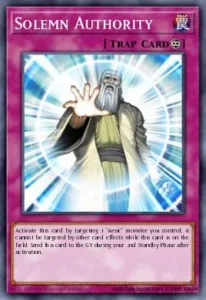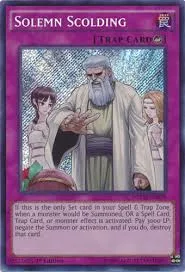The Solemn cards have long been a staple of competitive Yu-Gi-Oh! gameplay. For years, they’ve been relied upon as powerful counter-traps, giving players an answer to many high-impact plays. However, with the ever-evolving metagame, one pressing question remains: are the Solemn cards bad in 2034? In this article, we’ll take a deep dive into the current state of these iconic cards and explore whether they still hold up in today’s Yu-Gi-Oh! environment.
What Are the Solemn Cards?
To start, let’s quickly review what the Solemn cards are and why they’ve been so popular in the past. There are several variants, but the core cards are:
- Solemn Judgment
- Solemn Warning
- Solemn Strike
Each one serves a similar purpose: they negate the activation of a spell, trap, or monster effect. However, these cards come at a cost—usually paying life points—making them high-risk, high-reward choices.
In the past, the high-impact nature of these cards, coupled with their ability to shut down an opponent’s game plan, made them highly sought after. But in 2034, with new strategies and power creep, are the Solemn cards bad in 2034?

The Metagame in 2034: A New Landscape
Before we answer that question, let’s examine the current Yu-Gi-Oh! metagame. 2034 has brought several shifts in how the game is played. New mechanics, stronger monster effects, and faster-paced gameplay are the norm. Decks that focus on special summoning monsters quickly have become dominant, making it harder for players to set up traps or reactions like the Solemn cards. The rise of powerful Link and Xyz monsters also means that having a counter-trap ready may not be as easy as it once was.
Let’s take a look at some of the decks that are popular in 2034:
- Link Turbo: Decks focused on Link summoning, utilizing powerful monsters with multiple effects.
- Pendulum Swarm: Pendulum monsters with massive scaling and quick access to high-level synchro or Xyz plays.
- Virtual World: A fast-paced, combo-heavy deck that thrives on special summoning and interplays with multiple card effects.
These decks rely heavily on going fast, flooding the field with powerful monsters, and activating continuous effects that can overwhelm a player’s resources. This brings us to a key question: do the Solemn cards still hold up against these high-speed strategies?
Evaluating the Effectiveness of Solemn Cards in 2034
Let’s break down each Solemn card in the context of 2034’s fast-paced metagame.
Solemn Judgment
Solemn Judgment is perhaps the most iconic of the Solemn cards. It has the ability to negate almost anything—spells, traps, or monster effects—but at a steep cost: you pay half your life points. In 2034, Solemn Judgment may be seen as a risky play.
- Pro: Its versatility in negating almost anything is still valuable.
- Con: The life point cost is high. With faster games, you’re often playing against decks that can end the game quickly. Paying 4000 life points can be a huge disadvantage if you’re not in control of the duel.
While the card is powerful, are the Solemn cards bad in 2034 because of the risk of paying life points? In fast-paced games, this cost can sometimes be a deal-breaker.

Solemn Warning
Solemn Warning costs 2000 life points to negate the summon of a monster. In 2034, where powerful monster effects dominate the game, Solemn Warning still holds some value—but only in specific contexts. If your opponent is summoning a game-changing boss monster, the ability to stop that summon can be a lifesaver.
- Pro: Stopping a boss monster’s summon is a huge play, especially in a format where big monsters dominate.
- Con: 2000 life points is still a lot. Plus, with Link and Xyz monsters becoming more popular, it’s harder to stop special summons.
Despite its downsides, Solemn Warning can still be a crucial part of a deck that needs to stop a single key monster from hitting the board. But is it enough to justify its use in 2034?
Solemn Strike
Solemn Strike allows you to negate the summon of a monster or an effect, for 1500 life points. This card is somewhat of a middle ground between Solemn Judgment and Solemn Warning, offering negation without the hefty cost of losing half your life points.
- Pro: It’s a bit cheaper than Solemn Judgment and offers flexible negation.
- Con: Like the others, it costs life points, and with faster decks, paying 1500 life points might leave you vulnerable.
Still, Solemn Strike remains a strong contender in controlling the tempo of a duel, but it’s not without its limitations.

Key Stats: Are the Solemn Cards Bad in 2034?
To really understand the place of Solemn cards in the current meta, let’s look at some key stats:
- Speed of Meta: 2034’s metagame is faster, with combos and special summons happening in the first few turns.
- Top Decks: Decks like Link Turbo and Pendulum Swarm can quickly overwhelm your defenses, making slow traps like Solemn Judgment less effective.
- Life Points and Risk: The life point cost of these cards—especially Solemn Judgment—can become an issue in the new environment, where damage is dealt quickly.
It’s clear that while Solemn Judgment, Solemn Warning, and Solemn Strike still have their uses, they face stiff competition from newer, faster strategies. Are the Solemn cards bad in 2034, or is it just that other cards have become more suited to the new pace of the game?
Conclusion
The Solemn cards were once a staple of any competitive Yu-Gi-Oh! deck, but in 2034, they face challenges in keeping up with the fast-paced and combo-heavy metagame. Their ability to negate powerful effects and monster summons is still relevant, but the cost in life points, combined with the speed of modern decks, means these cards might not always be the best option.
So, are the Solemn cards bad in 2034? Or can they still hold their own in the right deck?




